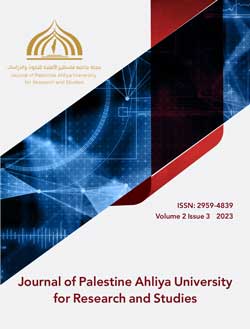The Optimal Sustainable Insulation Material by Using MCDM Analysis
DOI:
https://doi.org/10.59994/pau.2023.3.1Keywords:
CRITIC, Energy Efficiency, Insulation materials, MCDM Analysis, Multi-MOORA, Sustainable, TOPSIS, VIKORAbstract
Increasing fuel costs is the new norm, and an increase in energy consumption leads to many troubles, such as a growing of harmful environmental emissions and rise in energy consumption bills. Hence, it’s desirable and recommended to estimate the value of energy consumed for buildings in the first design state in order to reduce the impact of these issues, and obtain a sustainable building using thermal insulation for the buildings (walls, roofs, floors...). The purpose of this experimental analysis is to determine the best insulating material among 12 selected materials, as the properties of these materials were analysed based on several criteria. The study focuses on using multiple analysis methods in order to achieve the best results and to eliminate potential inconsistencies of data with available scientific methods. The evaluation is conducted via implementing three multiple criteria decision-making methods (MCDM)the full Multi-Objective Optimization on the basis of Ratio Analysis (MOORA) multiplication, rating the choices and selection the solution nearest to ideal, VIekriterijumsko KOmpromisno Rangiranje (VIKOR) and the method of ordering options by analogy with the optimal method (TOPSIS). In addition to the significance of the criteria, find the weights of the criterion in the analysis by using the correlation between criteria (CRITIC). Results based on pre-established methods showed consistent results, with the highest and worst performing materials identified in buildings. Extruded polystyrene foam (XPS) is ranked the best among other materials. The number of articles related to MCDM isn’t that high. Therefore, this study will contribute to filling the gap.
Downloads
References
Bozsaky, D. (2010, October). The development of thermal insulation materials from the beginnings to the appearance of plastic foams. In Proceedings of the 37th IAHS World Congress on Housing, Santander, Spain (pp. 26-29).
Gorjanc, D. Š., Dimitrovski, K., & Bizjak, M. (2012). Thermal and water vapor resistance of the elastic and conventional cotton fabrics. Textile Research Journal, 82(14), 1498-1506.
Greenspec. (2023). Insulation materials and their thermal properties. Retrieved from: https://www.greenspec.co.uk/
Hatefi, S. M., Asadi, H., Shams, G., Tamošaitienė, J., & Turskis, Z. (2021). Model for the sustainable material selection by applying integrated dempster-shafer evidence theory and additive ratio assessment (ARAS) method. Sustainability, 13(18), 10438.
Hwang, C.L., Yoon, K. (1981). Multiple attribute decision making: Methods and applications. Berlin, Springer Verlag.
InsulationGo. (2023). The history of thermal insulation. Retrieved from: https://insulationgo.co.uk/
Jones, A. Z. (2020, February 5). An Introduction to Density: Definition and Calculation. Annual Review of Materials Research Vol. 42:179-209
https://doi.org/10.1146/annurev-matsci-070511-155040
Kalaw, M. E. L., Bernardo, G. P., & Promentilla, M. A. B. (2022). Optimal Selection of Eco-Friendly Building Insulation Materials using a Spherical Fuzzy Multi-Criteria Decision Model. Chemical Engineering Transactions, 94, 223-228.
Kobryń, A., & Prystrom, J. (2016). A data pre-processing model for the TOPSIS method. Folia Oeconomica Stetinensia, 16(2), 219-235.
Krishnan, A. R., Kasim, M. M., Hamid, R., & Ghazali, M. F. (2021). A modified CRITIC method to estimate the objective weights of decision criteria. Symmetry, 13(6), 973.
Kusuma, A., & Ginting, G. (2020). Sistem Pendukung Keputusan Pemilihan Apoteker Terbaik Pada PT. Kimia Farma (Persero) Tbk Medan Menerapkan Metode Vikor. Jurnal Sistem Komputer Dan Informatika (JSON), 1(3), 252-257.
Lill, I., Kanapeckiene, L., Tupenaite, L., & Naimaviciene, J. (2017). Selection of the insulation materials for refurbishment purposes. Engineering Structures and Technologies, 9(2), 104-115.
Pfundstein, M., Gellert, R., Spitzner, M., & Rudolphi, A. (2012). Insulating materials: principles, materials, applications. Berlin: Birkhasuer-Publishers for Architecture.
Ruzgys, A., Volvačiovas, R., Ignatavičius, Č., & Turskis, Z. (2014). Integrated evaluation of external wall insulation in residential buildings using SWARA-TODIM MCDM method. Journal of Civil Engineering and Management, 20(1), 103-110.
Toberer, E. S., Baranowski, L. L., & Dames, C. (2012). Advances in thermal conductivity. Annual Review of Materials Research, 42, 179-209.
Uğur, L., & Baykan, U. (2017). A model proposal for wall material selection decisions by using analytic hierarchy process (AHP). Acta Physica Polonica A, 132(3), 577-579.
Ulutaş, A., Balo, F., Sua, L., Karabasevic, D., Stanujkic, D., & Popovic, G. (2021). Selection of insulation materials with PSI-CRITIC based CoCoSo method. Revista de la Construcción, 20(2), 382-392.
Waples, D. W., & Waples, J. S. (2004). A review and evaluation of specific heat capacities of rocks, minerals, and subsurface fluids. Part 2: fluids and porous rocks. Natural Resources Research, 13, 123-130.
Zavadskas, E. K., Stević, Ž., Turskis, Z., & Tomašević, M. (2019). A novel extended EDAS in Minkowski Space (EDAS-M) method for evaluating autonomous vehicles. Studies in Informatics and Control, 28(3), 255-264.

Downloads
Published
How to Cite
Issue
Section
License
Copyright (c) 2023 Journal of Palestine Ahliya University for Research and Studies

This work is licensed under a Creative Commons Attribution 4.0 International License.
مجلة جامعة فلسطين الاهلية للبحوث والدراسات تعتمد رخصة نَسب المُصنَّف 4.0 دولي (CC BY 4.0)











